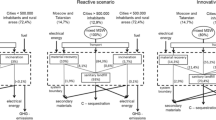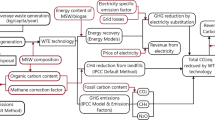Abstract
We focused on incineration of solid waste and resource recycling, when clarifying how to achieve carbon neutrality (CN) by 2050; we describe how future municipal solid waste incinerators (MSWIs) should operate. Specifically, eight low-carbon measures were set for four MSWIs located in the Tokyo waterfront area (Chuo, Minato, Shinkoto, and Ariake), and greenhouse gas (GHG) emissions were estimated for each scenario by combining these measures. We concluded that, in addition to MSW reduction and the introduction of biomass plastics, the improvement of power generation efficiency via plant renewal and wide area management of the MSWIs are useful when seeking to achieve CN. If the emission factor of electricity is to achieve CN in the future, the introduction of methanation is desirable in combination with wide area management, but if the emission factor of city-gas is also expected to achieve CN, an expansion of district heat utilization should rather be considered.












Similar content being viewed by others
References
World Meteorological Organization (2019) WMO statement on the state of the global climate in 2019. https://library.wmo.int/doc_num.php?explnum_id=10211. Accessed on 2022/7/17
Paris Agreement (2015) Report of the conference of the parties to the united nations framework convention on climate change. https://unfccc.int/fles/essential_background/convention/application/pdf/english_paris_agreement.pdf3. Accessed on 2022/7/17
National Institute for Environmental Studies, Japan (2021) Greenhouse Gas Inventory Office in Japan. Annex I countries greenhouse gas emissions data by sector by gas (1990–2019) https://www.nies.go.jp/gio/aboutghg/index.html. Accessed on 2022/7/17 (in Japanese)
Japan Center for Climate Change Actions (2020) GHG emissions in data (Japan). https://www.jccca.org/global-warming/knowleadge05. Accessed on 2022/7/15 (in Japanese)
Ministry of Economy, Trade and Industry (2020) Current status of greenhouse gas emissions, etc. https://www.meti.go.jp/shingikai/sankoshin/sangyo_gijutsu/chikyu_kankyo/ondanka_wg/pdf/003_03_00.pdf. Accessed on 2022/7/15 (in Japanese)
National Institute for Environmental Studies, Japan (2021) Time-series data from each sector of the 2021 Japanese Greenhouse Gas Inventory Report (NIR). https://www.nies.go.jp/gio/archive/nirdata/2021.html. Accessed on 2022/7/15 (in Japanese)
IEA (2004) Prospects for CO2 capture and storage. International Energy Agency Publications, Paris
Yao X, Guo Z, Liu Y, Li J, Feng W, Lei H, Gao Y (2019) Reduction potential of GHG emissions from municipal solid waste incineration for power generation in Beijing. J Clean Prod 241:118283
Rahman MM, Rahman SM, Rahman MS, Hasan MA, Shoaib SA, Rushd S (2021) Greenhouse gas emissions from solid waste management in Saudi Arabia—analysis of growth dynamics and mitigation opportunities. Appl Sci 11(4):1737
Christensen TH, Bisinella V (2021) Climate change impacts of introducing carbon capture and utilization (CCU) in waste incineration. Waste Manag 126:754–770
Bureau of Environment Tokyo Metropolitan Government (2021) Annual report on Tokyo Metropolitan Government's Municipal Cleaning Services (FY 2020 Results). https://www.kankyo.metro.tokyo.lg.jp/resource/general_waste/survey_results.files/230105R4nenpou.pdf. Accessed on 2023/1/8 (in Japanese)
Dou Y, Ohnishi S, Fujii M, Togawa T, Fujita T, Tanikawa H, Dong L (2018) Feasibility of developing heat exchange network between incineration facilities and industries in cities: case of Tokyo Metropolitan Area. J Clean Prod 170:548-558.9
Clean Authority of Tokyo (2021) General waste processing basic plan. https://www.union.tokyo23-seisou.lg.jp/kihonkeikaku/documents/ippannkeikakuhonbun.pdf. Accessed on 2022/7/15 (in Japanese)
Clean Authority of Tokyo (2016–2020) Waste management annual report. https://www.union.tokyo23-seisou.lg.jp/jigyo/renraku/kumiai/shiryo/jigyonenpo.html. Accessed on 2022/7/15 (in Japanese)
National Institute of Population and Social Security Research (2018) Regional population projections for Japan: 2015–2045. https://www.ipss.go.jp/site-ad/index_english/population-e.html. Accessed on 2022/7/15 (in Japanese)
Clean Authority of Tokyo (2010–2020). Waste property findings. https://www.union.tokyo23-seisou.lg.jp/gijutsu/kankyo/toke/seijyou.html. Accessed on 2022/7/15 (in Japanese)
Clean Authority of Tokyo (2010–2020) Incineration plant annual report. https://www.union.tokyo23-seisou.lg.jp/gijutsu/gijutsu/kumiai/shiryo/sagyonenpo.html. Accessed on 2022/7/15 (in Japanese)
National Institute for Environmental Studies, Japan (2022) National GHG inventory report of JAPAN (NIR). https://www.nies.go.jp/gio/en/aboutghg/index.html. Accessed on 2022/7/15 (in Japanese)
IPCC (2021) Climate change 2021. The physical science basis. In: Masson-Delmotte V, Zhai P, Pirani A, Connors Sl, Péan C, Berger S, Caud N, Chen Y, Goldfarb L, Gomis MI, Huang M, Leitzell K, Lonnoy E, Matthews JBR, Maycock TK, Waterfield T, Yelekçi O, Yu R, Zhou B (eds) Contribution of working group I to the sixth assessment report of the intergovernmental panel on climate change. Cambridge University Press, Cambridge (in press)
Hayasaki S, Oshita K, Kawai K, Takaoka M (2022) Estimation of greenhouse gas emission from municipal solid waste incinerators toward a decarbonized society. J Jpn Soc Mater Cycles Waste Manag 33:69–82 (in Japanese)
Tokyo Metropolitan Government (2019) Tokyo plastic strategy. https://www.kankyo.metro.tokyo.lg.jp/en/about_us/zero_emission_tokyo/strategy.html. Accessed on 2022/7/15 (in Japanese)
Clean Authority of Tokyo (2019) General waste processing basic plan revision study committee (3rd meeting) study document 2. https://www.union.tokyo23-seisou.lg.jp/kikaku/kihonkeikaku/documents/201902_03docc02.pdf. Accessed on 2022/7/15 (in Japanese)
Plastic Waste Management Institute (2022) An introduction to plastic recycling in Japan. https://www.pwmi.or.jp/data.php?p=panf. Accessed on 2022/7/15 (in Japanese)
Ministry of the Environment, Ministry of Land, Infrastructure, Transport and Tourism, Ministry of Economy, Trade and Industry, Ministry of Agriculture, Forestry and Fisheries, Ministry of Health, Labour and Welfare, Ministry of Education, Culture, Sports, Science and Technology, Ministry of Finance, Ministry of Foreign Affairs, Consumer Affairs Agency (2019) Plastic resource recycling strategy. https://www.meti.go.jp/shingikai/sankoshin/sangyo_gijutsu/haikibutsu_recycle/plastic_junkan_wg/pdf/001_02_02.pdf. Accessed on 2022/7/15 (in Japanese)
EX Research Institute Ltd (2010) The business report of measures to promote installation of waste heat recovery facilities. EX Research Institute Ltd, p 4121 (in Japanese)
Takaoka Y, Kawamura K, Kakuta Y (2014) Combined system integrates bio-gas production equipment and waste incineration in Nantan Area. J Jpn Soc Mater Cycles Waste Manag 25(1):36–42 (in Japanese)
Ministry of the Environment (2020) Nation survey on the state of discharge and treatment of municipal solid waste. https://www.env.go.jp/recycle/waste_tech/ippan/r1/index.html. Accessed on 2022/7/19 (in Japanese)
Ministry of Economy, Trade and Industry (2022) The sixth strategic energy plan. https://www.meti.go.jp/press/2021/10/20211022005/20211022005-1.pdf. Accessed on 2022/7/15 (in Japanese)
Central Research Institute of Electric Power Industry (2016) Comprehensive assessment of life cycle CO2 emissions from power generation technologies in Japan. https://criepi.denken.or.jp/hokokusho/pb/reportDownload?reportNoUkCode=Y06&tenpuTypeCode=30&seqNo=1&reportId=8713. Accessed on 2022/7/15 (in Japanese)
Japan Gas Association (2021) Carbon neutral challenge 2050. https://www.gas.or.jp/pdf/about/challenge2050.pdf. Accessed on 2022/7/15 (in Japanese)
Ohnishi S, Fujii M, Ohata M, Rokuta I, Fujita T (2018) Efficient energy recovery through a combination of waste-to-energy systems for a low-carbon city. Resour Conserv Recycl 128:394–405
Reiter G, Lindorfer J (2015) Global warming potential of hydrogen and methane production from renewable electricity via power-to-gas technology. Int J Life Cycle Assess 20:477–489
Author information
Authors and Affiliations
Corresponding author
Additional information
Publisher's Note
Springer Nature remains neutral with regard to jurisdictional claims in published maps and institutional affiliations.
Appendix
Appendix
See Figs. 13, 14, 15, 16, 17, 18, 19 and Tables 9, 10, 11.
Rights and permissions
Springer Nature or its licensor (e.g. a society or other partner) holds exclusive rights to this article under a publishing agreement with the author(s) or other rightsholder(s); author self-archiving of the accepted manuscript version of this article is solely governed by the terms of such publishing agreement and applicable law.
About this article
Cite this article
Matsuoka, T., Oshita, K. & Takaoka, M. Prediction of greenhouse gas emissions from municipal solid waste incinerators with consideration of utilization of heat and captured CO2 in the Tokyo waterfront area. J Mater Cycles Waste Manag 25, 1853–1875 (2023). https://doi.org/10.1007/s10163-023-01686-9
Received:
Accepted:
Published:
Issue Date:
DOI: https://doi.org/10.1007/s10163-023-01686-9











